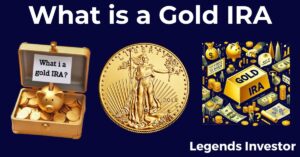Introduction to IRA Gold Investment
Gold has long been a symbol of wealth and stability, and incorporating it into an Individual Retirement Account (IRA) can be a powerful strategy for diversifying retirement savings. This article provides a comprehensive overview of IRA gold investment, including its benefits, types of gold investments, setup process, and more.
Explanation of an IRA (Individual Retirement Account)
What is an IRA?
An Individual Retirement Account (IRA) is a tax-advantaged account designed to help individuals save for retirement. There are several types of IRAs, including Traditional IRAs, Roth IRAs, SEP IRAs, and SIMPLE IRAs, each with its own set of rules and benefits. These accounts offer tax benefits that can help individuals build a larger retirement nest egg.
Gold as an Investment Option Within an IRA
Gold can be included in an IRA as a way to diversify investment portfolios and potentially hedge against inflation and economic instability. Unlike traditional investments such as stocks and bonds, gold offers a unique set of benefits and characteristics that make it an attractive option for retirement savings.
Benefits of Considering Gold for Retirement Savings
Historical Significance of Gold
Gold has been valued for thousands of years for its beauty, rarity, and durability. Historically, it has served as a store of value and a means of exchange. This long-standing reputation makes gold a trusted asset for preserving wealth over time.
Performance Compared to Other Investment Assets
Gold has demonstrated strong performance during periods of economic uncertainty and market volatility. Its price often rises when other investments falter, making it a valuable asset for protecting and growing retirement savings.
How Gold Can Counteract Inflation
Inflation erodes the purchasing power of currency, but gold tends to retain its value. As the cost of living rises, gold often appreciates in value, helping to safeguard the purchasing power of your retirement savings.
Gold’s Role in Diversifying an Investment Portfolio
Diversification is a key principle of investment strategy, aimed at spreading risk across different asset classes. Including gold in an IRA adds a layer of diversification, reducing overall portfolio risk and enhancing stability.
Types of IRAs That Allow Gold Investment
Traditional IRAs
Traditional IRAs allow for tax-deductible contributions, and the investments grow tax-deferred until withdrawal. Gold can be included in a Traditional IRA, providing an opportunity for long-term growth and stability.
Roth IRAs
Roth IRAs are funded with after-tax dollars, and qualified withdrawals are tax-free. Investing in gold through a Roth IRA can provide tax-free growth and withdrawals, which can be advantageous in retirement.
SEP IRAs
SEP IRAs are designed for self-employed individuals and small business owners. Contributions are tax-deductible, and investments grow tax-deferred. Gold can be included in a SEP IRA, offering similar benefits to a Traditional IRA.
SIMPLE IRAs
SIMPLE IRAs are similar to SEP IRAs but are intended for small businesses with fewer employees. Contributions are tax-deductible, and investments grow tax-deferred. Gold can be a part of a SIMPLE IRA, providing additional investment options.
Types of Gold Investments for an IRA
Physical Gold vs. Gold Stocks and Funds
Gold investments can be categorized into physical gold (bars, coins, and bullion) and gold-related financial products (stocks, ETFs, and mutual funds). Each type has its own set of advantages and considerations.
Pros and Cons of Gold Coins, Bullion, and ETFs
- Gold Coins: Coins like American Gold Eagles or Canadian Gold Maple Leafs are popular choices. They offer tangible assets and can be a collectible investment. However, they may come with higher premiums and storage costs.
- Gold Bullion: Gold bars and bullion offer a cost-effective way to invest in gold. They are generally sold at lower premiums compared to coins but require secure storage.
- Gold ETFs: Gold Exchange-Traded Funds (ETFs) offer liquidity and ease of trading. They provide exposure to gold without the need for physical storage. However, they come with management fees and may not provide the same tangible security as physical gold.
Relevance of Gold Quality and Purity in an IRA
Gold used in IRAs must meet specific purity requirements. Generally, gold must be at least 99.5% pure (24-karat). Ensuring the quality and purity of gold investments is crucial for compliance with IRS regulations and maintaining the value of your investment.
IRS-Approved Gold Products for IRA Investing
The IRS has specific requirements for gold investments within IRAs. Only certain gold products, such as American Gold Eagles, Canadian Gold Maple Leafs, and other IRS-approved coins and bullion, are eligible for inclusion in a gold IRA.
Setting Up a Gold IRA: The Process
Choosing a Custodian for a Gold IRA
A custodian is a financial institution responsible for managing and maintaining your gold IRA. When selecting a custodian, consider factors such as fees, reputation, customer service, and experience with gold investments.
The Paperwork and Logistics Involved
Setting up a gold IRA involves completing paperwork to establish the account and transfer funds from an existing retirement account. The custodian will guide you through the process, including selecting and purchasing gold investments.
Understanding the Fees and Costs
Gold IRAs may involve various fees, including setup fees, annual maintenance fees, and storage fees for physical gold. Understanding these costs is important for evaluating the overall value of a gold IRA.
Transfer Rollover from Existing Retirement Accounts
To fund a gold IRA, you can transfer or roll over funds from an existing retirement account, such as a 401(k) or traditional IRA. The custodian will assist with the rollover process to ensure it is completed correctly and without tax penalties.
Regulations and Compliance for Gold IRAs
IRS Rules for Gold IRAs
The IRS has specific rules governing gold IRAs, including purity requirements and approved gold products. Compliance with these rules is essential to avoid penalties and ensure the validity of your gold investments.
Storage Requirements for Physical Gold
Physical gold held in an IRA must be stored in an approved depository. The custodian will arrange for secure storage, ensuring that the gold is kept in compliance with IRS regulations and protected from theft or damage.
Contribution Limits and Tax Implications
Gold IRAs are subject to the same contribution limits and tax rules as other IRAs. Be aware of annual contribution limits, tax implications of withdrawals, and any potential tax benefits or liabilities associated with gold investments.
Required Minimum Distributions (RMDs) and How They Apply to Gold IRAs
Like other IRAs, gold IRAs are subject to Required Minimum Distributions (RMDs) once you reach age 72. You must withdraw a minimum amount each year, and this applies to gold investments as well. The custodian will help manage RMDs and ensure compliance.
Pros and Cons of a Gold IRA Investment
Potential for Long-Term Growth and Stability
Gold has a history of long-term growth and stability, making it a potentially valuable asset for retirement savings. Its ability to retain value and act as a hedge against economic uncertainties can enhance your retirement portfolio.
Gold’s Low Correlation with Other Asset Classes
Gold often has a low correlation with other asset classes, such as stocks and bonds. This means that its price movements are less likely to mirror those of other investments, providing additional diversification benefits.
Considerations for Liquidity and Selling Gold Within an IRA
While gold can offer stability, liquidity may be a concern. Selling physical gold within an IRA involves specific procedures and may incur fees. Gold ETFs and stocks may offer greater liquidity compared to physical gold.
The Risks Associated with Gold Price Volatility
Gold prices can be volatile, influenced by economic conditions, geopolitical events, and market sentiment. Investors should be prepared for price fluctuations and consider their risk tolerance when investing in gold.
Comparing Gold IRAs to Other Precious Metals
Other Precious Metals Eligible for IRAs
In addition to gold, other precious metals such as silver, platinum, and palladium can also be included in IRAs. Each metal has its own characteristics and investment potential, offering additional diversification options.
Performance Comparison Between Gold and Other Metals
Gold, silver, platinum, and palladium each have unique performance characteristics. Gold is often considered a safe haven asset, while silver and platinum have industrial applications that can influence their prices. Comparing their performance can help determine which metals best align with your investment goals.
Why Investors Might Choose Gold Over Other Metals
Gold is often chosen for its long-standing reputation as a store of value and its role as a hedge against inflation. Its historical significance and stability make it a popular choice for retirement savings compared to other precious metals.
Diversification Within Precious Metals IRAs
Investing in a mix of precious metals within an IRA can provide additional diversification. Allocating investments across gold, silver, platinum, and palladium can enhance portfolio stability and risk management.
Gold IRA Maintenance and Monitoring
Regular Reviews and Rebalancing of a Gold IRA Portfolio
Regularly reviewing and rebalancing your gold IRA portfolio is essential for maintaining alignment with your investment goals. Adjustments may be needed based on market conditions, performance, and changes in your financial situation.
Monitoring Gold Market Trends and Assessing Their Impact
Stay informed about gold market trends and their potential impact on your investments. Economic indicators, geopolitical events, and market sentiment can influence gold prices and affect your portfolio.
When to Make Adjustments to Your Gold Investment
Deciding when to adjust your gold investment involves considering factors such as changes in market conditions, performance, and your financial goals. Regular assessments will help you make informed decisions about buying, selling, or reallocating gold investments.
Utilizing Experts and Advisors for Gold IRA Management
Consulting with financial advisors or experts specializing in gold IRAs can provide valuable insights and guidance. They can help with investment decisions, portfolio management, and ensuring compliance with regulations.
Case Studies and Success Stories
Real-Life Examples of Successful Gold IRA Investments
Examining real-life case studies and success stories can provide inspiration and insights into effective gold IRA investing. Learning from others’ experiences can help you make informed decisions and avoid common pitfalls.
Lessons Learned from Gold IRA Investing
Understanding the lessons learned from successful and unsuccessful gold IRA investments can offer valuable guidance. Insights into market trends, investment strategies, and management practices can enhance your approach to gold investing.
What to Avoid Based on Investor Experiences
Avoiding common mistakes and pitfalls is crucial for successful gold IRA investing. Learning from others’ experiences can help you navigate challenges and make more informed decisions about your investments.
Analyzing Gold’s Performance During Major Economic Events
Studying how gold has performed during major economic events, such as recessions or financial crises, can provide valuable context for its role in a retirement portfolio. Historical performance can offer insights into its potential benefits and risks.
Conclusion: Is a Gold IRA Right for You?
Personal Financial Goals and Risk Tolerance
Determining whether a gold IRA is right for you involves evaluating your personal financial goals and risk tolerance. Consider how gold aligns with your retirement strategy and investment preferences.
Aligning Retirement Strategies with Gold Investing
Integrating gold into your retirement strategy can enhance diversification and stability. Aligning your investment approach with gold can help achieve long-term financial goals and manage risk effectively.
Seeking Professional Advice for Personalized Investment Planning
Consulting with financial advisors or investment professionals can provide personalized guidance on gold IRAs. Professional advice can help tailor your investment strategy to your specific needs and objectives.
Summary of Key Takeaways About Gold IRAs
In summary, a gold IRA can be a valuable addition to a retirement portfolio, offering benefits such as diversification, inflation protection, and long-term growth potential. Understanding the different types of gold investments, the setup process, and key considerations will help you make informed decisions and effectively incorporate gold into your retirement strategy.
By leveraging the advantages of gold, staying informed about market trends, and seeking professional advice, you can optimize your gold IRA investment and work towards a secure and prosperous retirement.



